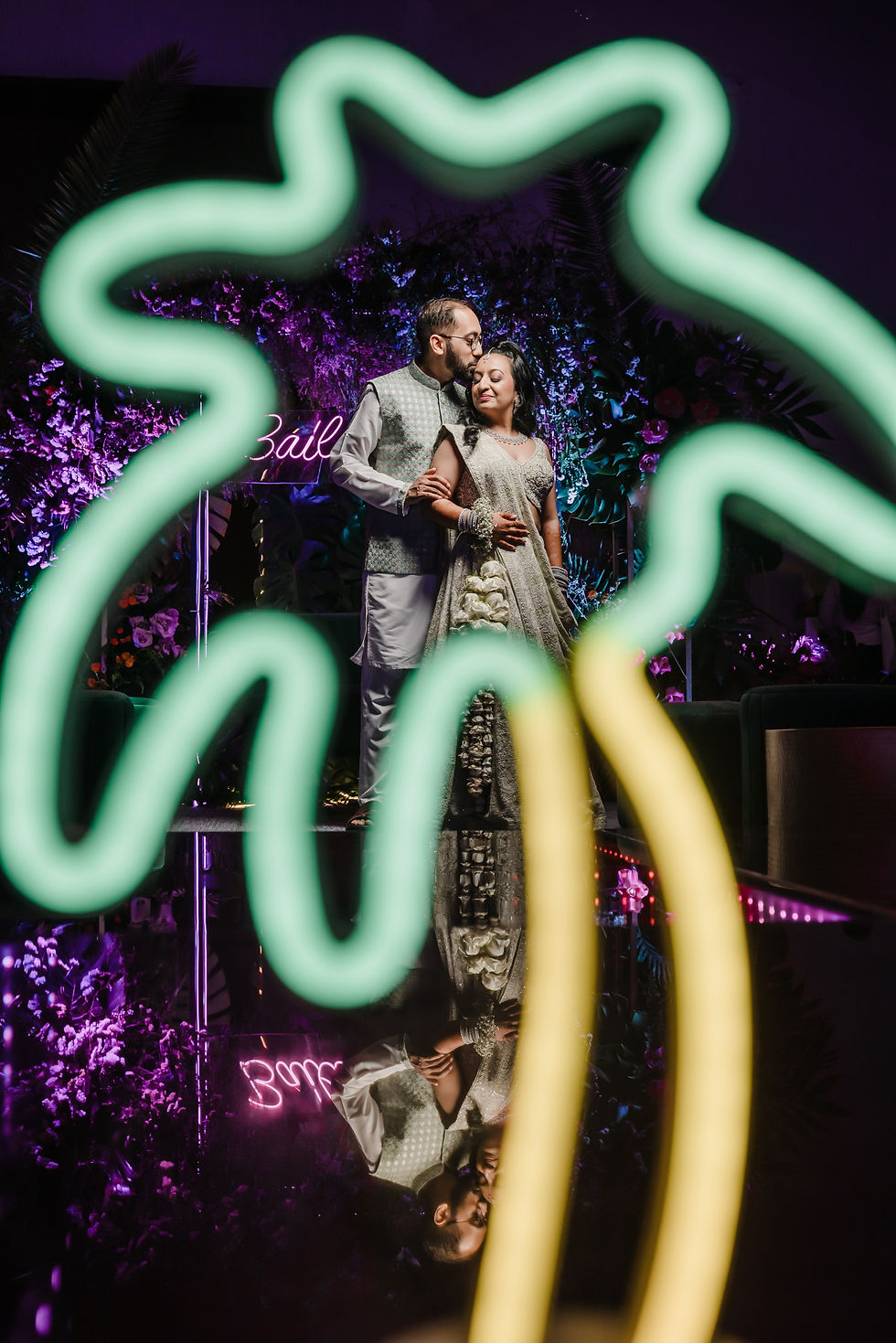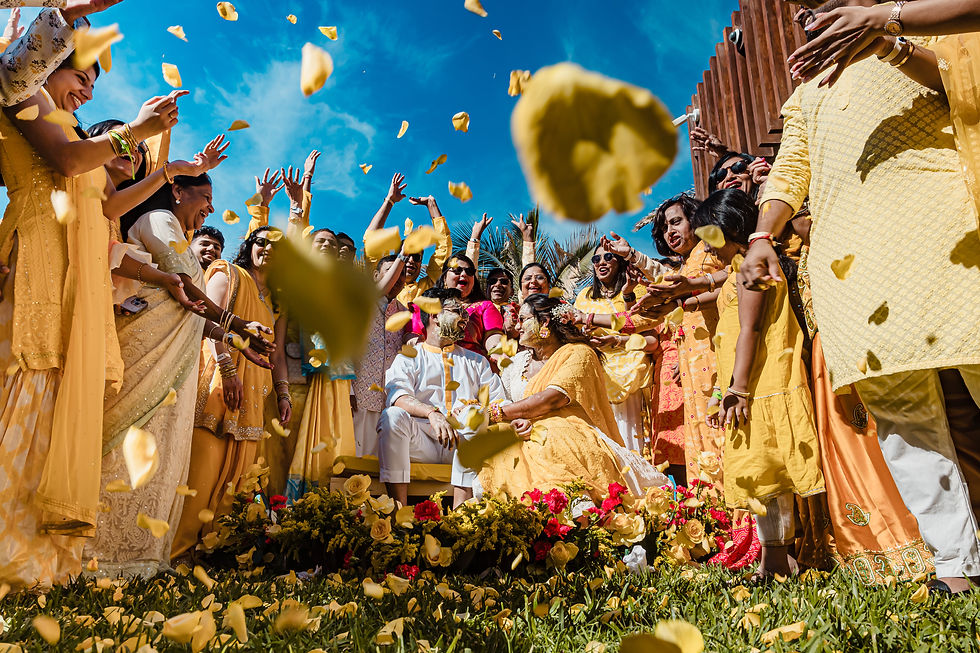Gujarati Wedding Pre-Ceremony Rituals: Celebrated in Destination Weddings Across Mexico
- Saptapadi Studio
- Aug 14
- 4 min read
Updated: Aug 14
Planning a Gujarati wedding in Mexico means blending vibrant cultural traditions with breathtaking tropical backdrops. These weddings are more than just a single day—they’re a multi-day celebration filled with rituals that carry deep cultural meaning, strengthen family bonds, and build excitement for the big day.

While the wedding ceremony itself is the centerpiece, the days leading up to it are often the most colorful and joy-filled, with music, laughter, and sacred blessings. In Gujarati culture, these pre-ceremony rituals are woven seamlessly into the destination wedding itinerary, often taking place right at the resort so guests can enjoy every moment together.
Here’s a closer look at five Gujarati pre-ceremony rituals you’ll often see during the actual wedding festivities at a resort in Cancun, Los Cabos, Puerto Vallarta, or the Riviera Maya—and how they shine in a destination wedding setting.

1. Mehndi Night 🌿
The Mehndi ceremony marks the official start of the wedding celebrations. The bride sits surrounded by friends and family as skilled mehndi artists paint her hands and feet with intricate designs—florals, paisleys, and sometimes even hidden initials or portraits.In Gujarati weddings, it’s not uncommon for the groom’s family and female guests to also have simple designs applied, turning the event into a shared experience.
At a destination wedding in Mexico, Mehndi night often becomes a full-scale welcome party. Picture an ocean-view terrace lit with fairy lights, guests in jewel-toned lehengas and kurtas, music blending the beat of the dhol with a tropical breeze, and the scent of fresh flowers in the air. It’s more than a ritual—it’s a joyful reunion of loved ones from around the world, all gathered in paradise to celebrate.

2. Sangeet Night with Garba and Raas 💃
The Sangeet is an evening of music and dance, where both sides of the family come together to perform choreographed numbers, share heartfelt speeches, and celebrate the couple. In Gujarati culture, the night often takes on an even livelier tone with the inclusion of Garba and Raas—folk dances that have been passed down through generations.
Garba is danced in a graceful circular formation, symbolizing the cycle of life and honoring goddess Amba. Raas is faster-paced, using decorated sticks (dandiya) in a playful back-and-forth rhythm between partners. Both dances are filled with color, movement, and laughter.
At a destination wedding in Mexico, the Sangeet with Garba and Raas might take place under a starlit sky, with the resort’s terrace or ballroom transformed into a festival of light and sound. Imagine swirling skirts, jingling anklets, and guests from different cultures joining in the dance—a perfect blend of tradition and tropical celebration.

3. Pithi (Haldi) 🌼
The Pithi ceremony, the Gujarati equivalent of Haldi, is a ritual of purification, blessings, and joy. A paste made from turmeric, sandalwood, and rosewater is lovingly applied to the bride and groom by family members, symbolizing beauty, protection, and a fresh start as they enter married life.
It’s a playful, laughter-filled event—family members teasing the couple, trying to smear turmeric in unexpected places, and photographers capturing candid moments of joy.In Mexico, Pithi ceremonies are often held by the beach, on garden lawns, or beside shimmering pools, with décor drenched in yellow and orange to match the mood. The sound of the ocean becomes part of the celebration, making the ritual feel both intimate and cinematic.

4. Ganesh Sthapana, Grah Shanti Puja & Mandap Muhurat 🪔🌸
These sacred rituals are often performed together the morning before the wedding day.
Ganesh Sthapana: A small idol of Lord Ganesha is installed to bless the couple and remove obstacles.
Grah Shanti Puja: A ceremony asking for peace, harmony, and prosperity in the couple’s married life.
Mandap Muhurat: The official blessing of the mandap, the sacred space where the wedding vows will be exchanged.
In a destination wedding in Mexico, these pujas might take place in a shaded garden, under a floral canopy of marigolds and tropical blooms, or even indoors in a beautifully decorated ballroom. The soft chanting of mantras blends with the gentle sounds of waves in the distance, creating an atmosphere of serenity and spiritual grounding before the joyful chaos of the wedding day begins.

5. Mameru / Mosaalu 🎁
The Mameru tradition is a deeply emotional moment for the bride’s family. Her maternal uncle (mama) visits bearing gifts such as a traditional saree, gold jewelry, and sweets—symbols of love, blessings, and support as she begins her new life.
At a destination wedding in Mexico, Mameru might be held as a morning ceremony in a private suite, on a shaded terrace, or in an intimate garden corner of the resort. After the exchange of gifts, families often share a relaxed breakfast or brunch together, giving everyone a chance to connect before the main wedding events. The emotion in the room is palpable—tears, smiles, and warm embraces that speak of a lifetime of love.

Capturing These Moments in Mexico
At Saptapadi Studio, we believe these pre-ceremony rituals are just as important as the wedding itself. They’re full of raw emotion, color, movement, and meaning—the very elements we specialize in capturing. From the swirling Garba dances to the tender moments of Mameru, we document each tradition with a blend of candid storytelling and creative artistry, ensuring that your Gujarati wedding in Mexico is remembered for generations.
✨ Want to dive deeper into how Gujarati weddings come to life in Mexico?
Read our Gujarati Wedding Ceremony in Mexico Guide for a complete look at the ceremonies, colors, and celebrations that make these events unforgettable.
Planning your own Gujarati wedding in Mexico? Let us help you honor every tradition while embracing the beauty of a destination celebration.


Comments